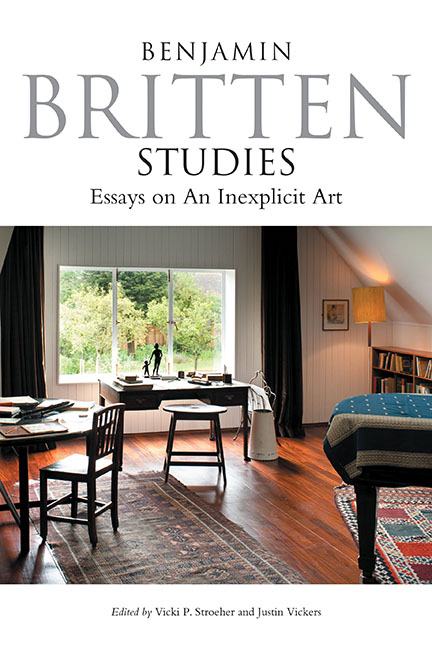Book contents
- Frontmatter
- Dedication
- Epigraph
- Contents
- List of Illustrations
- List of Musical Examples
- List of Tables
- Notes on Contributors
- Acknowledgements
- Bibliographic and General Abbreviations
- Editors’ Preface
- Introduction: Writing About Britten
- Part I Identity: Exile and Return
- Part II Britten and Intimacy
- Part III Britten and His Craft
- 8 “Take These Tokens That You May Feel Us Near”: Remembrance and Renewed Citizenship in Britten's Gloriana
- 9 Traces of Nō: Modularity and Saturation in The Burning Fiery Furnace and The Prodigal Son
- 10 Britten and the Augmented Sixth
- 11 Quickenings of the Heart: Notes on Rhythm and Tempo in Britten
- Part IV Britten and Matters of Practicality
- Conclusion and Epilogue
- Works Cited
- Index
11 - Quickenings of the Heart: Notes on Rhythm and Tempo in Britten
from Part III - Britten and His Craft
Published online by Cambridge University Press: 25 October 2017
- Frontmatter
- Dedication
- Epigraph
- Contents
- List of Illustrations
- List of Musical Examples
- List of Tables
- Notes on Contributors
- Acknowledgements
- Bibliographic and General Abbreviations
- Editors’ Preface
- Introduction: Writing About Britten
- Part I Identity: Exile and Return
- Part II Britten and Intimacy
- Part III Britten and His Craft
- 8 “Take These Tokens That You May Feel Us Near”: Remembrance and Renewed Citizenship in Britten's Gloriana
- 9 Traces of Nō: Modularity and Saturation in The Burning Fiery Furnace and The Prodigal Son
- 10 Britten and the Augmented Sixth
- 11 Quickenings of the Heart: Notes on Rhythm and Tempo in Britten
- Part IV Britten and Matters of Practicality
- Conclusion and Epilogue
- Works Cited
- Index
Summary
The communicative power of Britten's music rests in part on an aspect of his style rarely discussed in any depth: the rhythms. Britten was no radical, rhythmically. He did not – as his colleague Michael Tippett did – accommodate post-Stravinskian metric fragmentation to the “sprung” metric irregularities of the Elizabethan madrigal; nor did he – as his nearcontemporary Olivier Messiaen did – organize durations by numerical series, treating rhythm as a musical parameter to be structured separately from the pitch dimension. Britten's music, like Shostakovich's, arguably shows a more pronounced concern with the regular and symmetrical, though such affinities were not always stressed by early press critics: William Glock, in a 1943 Observer column, remarked on the Russian's “vigorous and pointed rhythms expressing the spirit of industrialism,” then turned to his countryman: “By comparison, Britten's world is accidental. His invention is poured into his melody, his long lines, his orchestral colour: the harmonies, which safeguard the first two, can be rather spidery and uncomforting.” The silence regarding Britten's rhythms is representative of a critical line already in place. Only when commentary alights upon one much-mentioned case – that of Purcell's music – does the topic of rhythm arise with any specificity, often amid claims of stylistic “influence.” Britten's operatic characters in Peter Grimes (1945), as Arved Ashby has recently observed, sing “tuneful airs” with lilting dance motions that define personality, bearing, and being: with Grimes himself, “sociopathology is manifest […] as ametricality, as removal from the communal dance,” while the laudanum-addled gossip Mrs. Sedley is all simple and obsessive repetitions.
Boldly stated rhythmic repetitions – for all the critical reticence – are an easily recognized aspect of Britten's rhetorically forthright musical style. The meanings of those repetitions, though, are not simple. In the Chacony of String Quartet No. 2 (completed in 1945 soon after Grimes), the influence of Purcell is again palpably a rhythmic affair. The theme's tensile kicking motions – notated as dotted rhythms – bind the first seven variations into a coherent paragraph, even as the textural interplay of parts shifts rapidly. One finds comparable rhythmic concentration in the scenic realm of Britten's operas, invariably linked to the physical reality of onstage action, or hinting at underlying enigma.
- Type
- Chapter
- Information
- Benjamin Britten Studies: Essays on An Inexplicit Art , pp. 319 - 348Publisher: Boydell & BrewerPrint publication year: 2017

